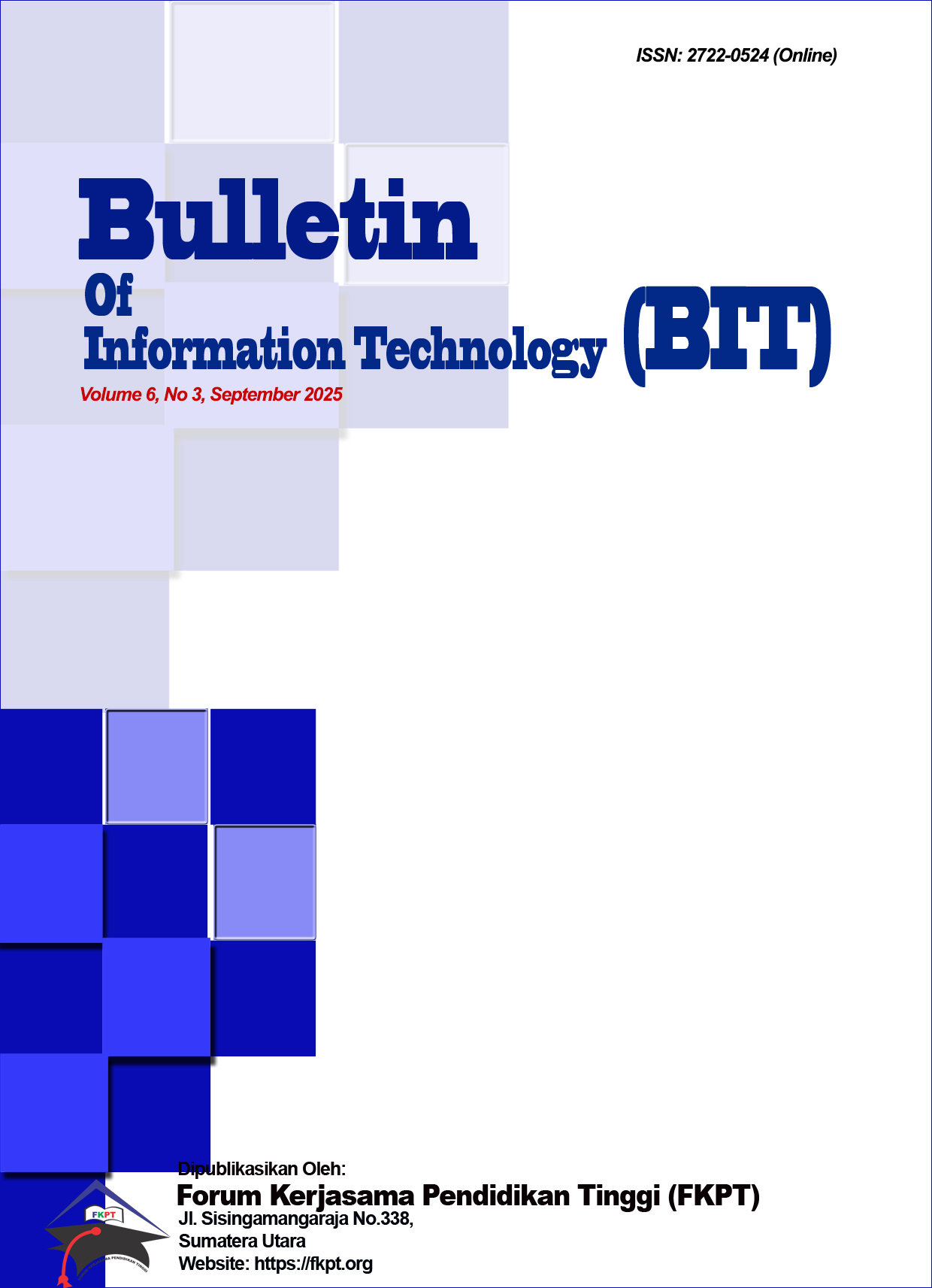Aplikasi Belajar Matematika di Sekolah Dasar Negeri 2 Lape Berbasis Android Untuk Meningkatkan Pemahaman Siswa
Abstract
This study aims to develop an Android-based Mathematics Learning Application as an interactive and engaging learning medium to enhance elementary school students' understanding, particularly at Lape 2 Public Elementary School. The research employs the Waterfall software development model, which consists of five stages: requirements analysis, design, implementation, testing, and maintenance. Data collection was carried out through the distribution of questionnaires as well as the administration of pre-tests and post-tests to fifth-grade students. The application was developed with core features including learning materials, practice questions, automatic scoring, and learning outcome reports. Testing was conducted using the black box testing method to evaluate the application's functionality, and the improvement in students’ understanding was analyzed using the N-Gain method. The results indicate an improvement in students’ understanding, categorized as moderate to high, after using the application. This application is expected to serve as an effective, enjoyable, and relevant alternative learning medium that meets the needs of elementary school students.
References
S. Zuhri, I. G. Suwindia, and I. M. A. Winangun, “Literasi digital dan kecakapan abad ke-21 : analisis komprehensif dari literatur terkini,” vol. 5, no. 2, pp. 149–155, 2024, doi: https://doi.org/10.29210/07essr500300 Contents.
A. D. Putri, D. Juandi, and Turmudi, “Realistic mathematics education and mathematical literacy: a meta-analysis conducted on studies in Indonesia,” J. Educ. Learn., vol. 18, no. 4, pp. 1468–1476, 2024, doi: 10.11591/edulearn.v18i4.21650.
D. Maulidyawati, S. Esabella, and T. Andriani, “G-Discovery: Pemahaman Konsep Matematika Anak Berbasis Android,” Nuansa Inform., vol. 15, no. 2, pp. 70–77, 2021, doi: 10.25134/nuansa.v15i2.4130.
I. Azro’i, F. K. A. Putri, N. L. Nisfa, A. K. Anisah, and D. Fitriyanti, “Pengembangan Aplikasi Android Matematika Untuk Anak Usia Dini,” vol. 13, no. 2, pp. 359–369, 2024, doi: 10.26877/paudia.v13i2.467.
A. P. Setiawan, H. Hetilaniar, and A. Kuswidyanarko, “Pengembangan Media Pembelajaran Matematika Berbasis Aplikasi Android Untuk Menarik Minat Belajar Siswa Di Sekolah Dasar,” J. Pendidik. dan Konseling, vol. 4, pp. 1565–1569, 2022.
A. Septian, E. Monariska, A. I. Fatuha, and A. Lestari, “Pengembangan Aplikasi Kelas Pintar sebagai Media Pembelajaran Matematika Berbasis Android untuk Siswa,” Intellect. Math. Educ., vol. 2, no. 1, pp. 45–58, 2024, doi: 10.59108/ime.v2i1.67.
Y. F. Basya, A. F. Rifa’i, and N. Arfinanti, “Pengembangan Mobile Apps Android sebagai Media Pembelajaran Matematika Berbasis Pendekatan Kontekstual untuk Memfasilitasi Pemahaman Konsep,” J. Pengemb. Pembelajaran Mat., vol. 1, no. 1, pp. 1–9, 2019, doi: 10.14421/jppm.2019.11.1-9.
M. B. Satria and H. Ardiansyah, “Analisis dan Perancangan Sistem Raport Digital Metode Waterfall,” J. Educ., vol. 5, no. 2, pp. 5143–5151, 2023, doi: 10.31004/joe.v5i2.1253.
M. R. Wayahdi and F. Ruziq, “Pemodelan Sistem Penerimaan Anggota Baru dengan Unified Modeling Language (UML) (Studi Kasus: Programmer Association of Battuta),” J. Minfo Polgan, vol. 12, no. 1, pp. 1514–1521, 2023, doi: 10.33395/jmp.v12i1.12870.
M. Mansyuruddin, I. Astuti, and E. Enawaty, “Penggunaan Media Pembelajaran Berbasis Android pada Mata Pelajaran Perawatan Sistem Injeksi Sepeda Motor Kelas XI di SMK Negeri 9 Pontianak,” JIIP - J. Ilm. Ilmu Pendidik., vol. 6, no. 4, pp. 2183–2187, 2023, doi: 10.54371/jiip.v6i4.1734.
R. Wahyudi and S. Munir, “RANCANG BANGUN APLIKASI MOBILE CLIENT CRM BERBASIS ANDROID STUDI KASUS CV ESINDO MULTI TATA,” J. Inform. Terpadu, vol. 4, no. 2, pp. 34–39, 2018, [Online]. Available: https://journal.nurulfikri.ac.id/index.php/JIT
J. W. Kusuma et al., Dimensi Media Pembelajaran (Teori dan Penerapan Media Pembelajaran Pada Era Revolusi Industri 4.0 Menuju Era Society 5.0), no. August. 2023. [Online]. Available: http://eprints.uny.ac.id/id/eprint/49351
N. A. K. Sari, Yuniawatika, and S. Mas’ula, “Analisis Kebutuhan Media Pembelajaran Materi Operasi Hitung Bilangan Cacah pada Siswa Kelas II Sekolah Dasar,” J. Pembelajaran, Bimbingan, dan Pengelolaan Pendidik., vol. 4, no. 2, 2024, doi: 10.17977/um065.v4.i2.2024.2.
N. Y. Saidah, S. M. Amin, and M. Mustaji, “Pengembangan Perangkat Pembelajaran Penjumlahan Dan Pengurangan Pecahan Desimal Untuk Kelas V Sekolah Dasar Dengan Pendekatan Matematika Realistik,” J. Rev. Pendidik. Dasar J. Kaji. Pendidik. dan Has. Penelit., vol. 5, no. 3, 2019, doi: 10.26740/jrpd.v5n3.p1116-1122.
Samsinar, H. Nufus, E. Isyani, and Fajrina, “sebagai kelas ekperimen dan kelas VIII,” J. Pendidik. Mat. Malikussaleh, vol. 1, no. 2, pp. 95–104, 2021.
R. Efendi, A. P. G. Hasibuan, Elvina, and P. S. Siregar, “Canva Application-Based Learning Media on Motivation and Learning Outcomes,” Int. J. Elem. Educ., vol. 7, no. 2, pp. 342–352, 2023, doi: 10.23887/ijee.v7i2.53956.
U. Wiranda and Masniladevi, “Pengaruh Media Pembelajaran Berbasis Android Pada Materi Pecahan Terhadap Hasil Belajar Siswa Di Sekolah Dasar,” J. Pendidik. Tambusai, vol. 4, no. 3, pp. 3045–3051, 2020, [Online]. Available: https://jptam.org/index.php/jptam/article/view/808
M. Isnaini, H. Fauziyah, A. Riwana, U. Rohmah, and R. Haryanto, “Pengaruh Pelatihan dan Kompensasi Terhadap Kinerja Karyawan BMT NU Jawa Timur,” J. Media Wahana Ekon., vol. 20, no. 2, pp. 285–300, 2023, doi: 10.31851/jmwe.v20i2.11364.
Copyright (c) 2025 Shinta Esabella, Hilmy Adrizul Rifqi Hidayat

This work is licensed under a Creative Commons Attribution 4.0 International License.
Authors who publish with this journal agree to the following terms:
- Authors retain copyright and grant the journal right of first publication with the work simultaneously licensed under Creative Commons Attribution 4.0 International License that allows others to share the work with an acknowledgment of the work's authorship and initial publication in this journal.
- Authors are able to enter into separate, additional contractual arrangements for the non-exclusive distribution of the journal's published version of the work (e.g., post it to an institutional repository or publish it in a book), with an acknowledgment of its initial publication in this journal.
- Authors are permitted and encouraged to post their work online (e.g., in institutional repositories or on their website) prior to and during the submission process, as it can lead to productive exchanges, as well as earlier and greater citation of published work (Refer to The Effect of Open Access).




.png)
.png)



